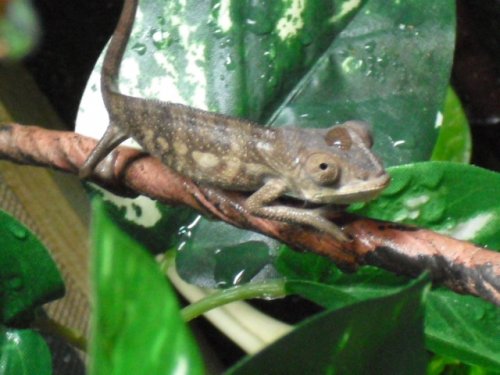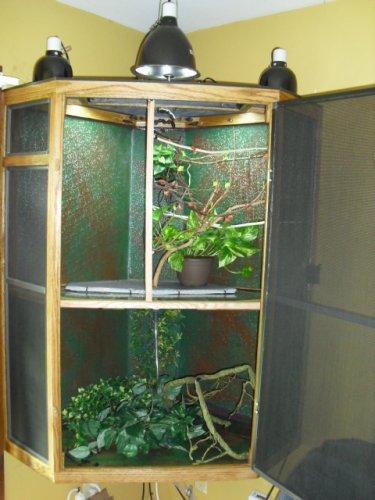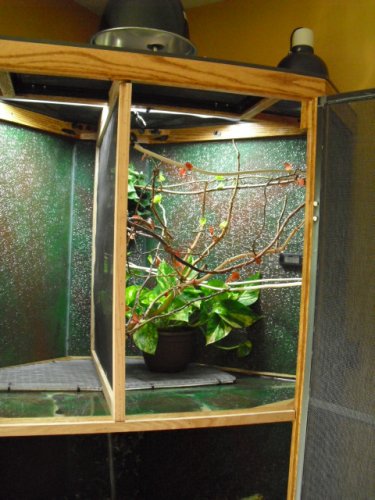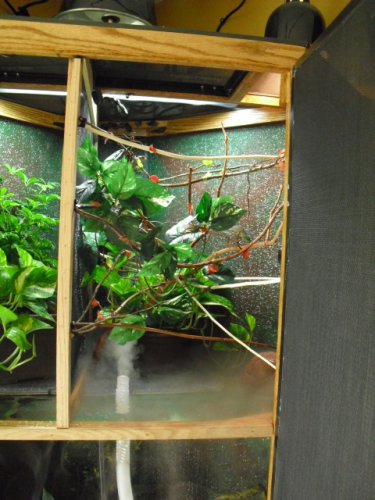4 days a go I received my first chamy.He's a 2 and half month old ambilobe panther I named Midas.I have some concerns hopefully some of you experienced keepers on here can help me with.First off he did not seem to want to eat,but finally saw him eat a couple of crickets yesterday.Tried to cup feed but has no interest.I offered him sm.crickets,silkworms,roaches and superworms,all small.He has been showing some very dark colors.He has been climbing the screen and getting to the top and hanging upside down. A couple times I've seen him hanging down from the top by his rear legs.I put my hand under him and he came down,then lowered him to a branch.I wonder about this behavior. Some of my information is:Midas is a Ambilobe panther from chameleon paradise,his father is 24k.Been dusting insects with calcium.Setup has mistking mister coming on 4 times a day for 4 minutes.Just added a fogger because was having hard time keeping humidity up.His fecals been quite dark looking.His cage was built by me and is mounted to the wall in the corner of my living room.Its 30 by 30 by 48 and I divided that in half and partitioned that half off again.So its 15 by 15 by 24 where hes at now.Have a arcadia 6% and 6500 ho light and 60 w basking bulb 2 inches above cage.Temps are about 79 and basking area is about 83.Humidity was in mid 40's but now with fogger 63%.Have a small pothos in with him and plenty of branches and vines.I live in Maine,have tried to do this right any have done much research.But would really appreciate any advise from you veteran keepers out there.Also I'm starting to raise roaches,silkwoorms and keeping crickets on hand for him.Thanks,Mike
Navigation
Install the app
How to install the app on iOS
Follow along with the video below to see how to install our site as a web app on your home screen.
Note: This feature may not be available in some browsers.
More options
You are using an out of date browser. It may not display this or other websites correctly.
You should upgrade or use an alternative browser.
You should upgrade or use an alternative browser.
New baby panther
- Thread starter murphz71
- Start date
carol5208
Chameleon Enthusiast
Hi and welcome to chameleon ownership. It is quite normal for them not to eat much at first and also hanging upside down is normal too! My only suggestion is to make your basking area a little hotter for him. Maybe bump it up about 5-7 degrees. 79 is a little high for the ambient. There is not much difference between that and the basking area as you have it now, but if you cannot lower it I don't think it will kill him either. You cage looks nice. Are you planning on getting others, or just giving him the whole enclosure when he gets bigger? That would be a nice big space for him if so. I would add some more foliage to the current set up also so he can feel more secure.
julies liam
New Member
yeh hanging about is normal mine hangs upside down all the time. (i also have a panther)
you do need more plants for sure, and your enclouser looks really good thou me and my partner want to build one like yours wen our liam gets bigger...looks good mate
you do need more plants for sure, and your enclouser looks really good thou me and my partner want to build one like yours wen our liam gets bigger...looks good mate
Chameleon Company
Avid Member
4 days a go I received my first chamy.He's a 2 and half month old ambilobe panther I named Midas.I have some concerns hopefully some of you experienced keepers on here can help me with.First off he did not seem to want to eat,but finally saw him eat a couple of crickets yesterday.Tried to cup feed but has no interest.I offered him sm.crickets,silkworms,roaches and superworms,all small.He has been showing some very dark colors.He has been climbing the screen and getting to the top and hanging upside down. A couple times I've seen him hanging down from the top by his rear legs.I put my hand under him and he came down,then lowered him to a branch.I wonder about this behavior. Some of my information is:Midas is a Ambilobe panther from chameleon paradise,his father is 24k.Been dusting insects with calcium.Setup has mistking mister coming on 4 times a day for 4 minutes.Just added a fogger because was having hard time keeping humidity up.His fecals been quite dark looking.His cage was built by me and is mounted to the wall in the corner of my living room.Its 30 by 30 by 48 and I divided that in half and partitioned that half off again.So its 15 by 15 by 24 where hes at now.Have a arcadia 6% and 6500 ho light and 60 w basking bulb 2 inches above cage.Temps are about 79 and basking area is about 83.Humidity was in mid 40's but now with fogger 63%.Have a small pothos in with him and plenty of branches and vines.I live in Maine,have tried to do this right any have done much research.But would really appreciate any advise from you veteran keepers out there.Also I'm starting to raise roaches,silkwoorms and keeping crickets on hand for him.Thanks,Mike
Direct basking spot should be in the low-mid 90's. Daytime ambient in the mid 80's, but not vital so long as the basking is warm enough. The animal will thermo-regulate given the proper range to move between. Nighttime can drop into the low 60's without concern, although mid 70's is preferable.
julies liam
New Member
it does look really good but i would still say more plants 
if u go on my profile u can see my enclosure for my panther
if u go on my profile u can see my enclosure for my panther
junglefries
Avid Member
circus
I have found little panthers to be cirque soliel stars. Like little pinballs, just everywhere.
I have found little panthers to be cirque soliel stars. Like little pinballs, just everywhere.
Chameleon Company
Avid Member
Does this look better?The chameleon care resources care sheet for panthers on this website says baby/juvenile up to 9 months-ambient 72-80 and basking 82.Seems to be lots of conflicting information or opinions about this.??
Don't know who wrote it, or where they got it, but it is wrong. By a wide margin. Whoever wrote it is more than welcome to call me out on it.
You tell me, do juvenile panthers grow up in a different part of Madagascar than adults ? You can go to weather.com, and other sources, and find daytime highs for such as Nosy Be and Tamatave, just to name two. They sure as heck do not conform with what you just told me.
It is unfortunate that you got bad info. But more importantly, you need your basking spot in the low 90's. Temperature range is far more crucial than ambient temp.
Good luck.
OBTW, once he is 4" total length, he can roam the largest cage that you put him in. No dividers needed.
Thanks Jim for the info.It makes perfect sense to me,I did check the weather in Ambilobe and lows 68 to highs 98 this week.Also you said at 4 inch,which is about the size of my little guy,he could use the whole cage which is 30 by 30 by 48 inches.That would be great,but I'm just confused even more now.That same care sheet says 16 by 16 by 30 for babies/juveniles.Also chameleon paradise-Bruce Galbraith,where I purchased my little guy,also confirms the basking temps and the small cage,as the same as the care sheet.I really just want whats best for the little guy.Hope hes not cold,but don't want to bake him either.Not sure what to do now,but I do appreciate your advise.
sandrachameleon
Chameleon Enthusiast
Does this look better?The chameleon care resources care sheet for panthers on this website says baby/juvenile up to 9 months-ambient 72-80 and basking 82.Seems to be lots of conflicting information or opinions about this.??
I agree with what is in the care sheet for temps, with 82ish being the basking temp while he is young. Thats essentially what I have done. Keeping it too hot can result in dehydration.
Chameleon Company
Avid Member
I agree with what is in the care sheet for temps, with 82ish being the basking temp while he is young. Thats essentially what I have done. Keeping it too hot can result in dehydration.
Since you mention it, where do you get this "dehydration" ? Hydration is a simple product of providing either humidity, or water to drink. It is essentially independent of temperature with regard to a living creature. Further, when we look at the ambient temps for this critter's natural habitat, we do not see one gradient for the juveniles, and another for the adults !
While surely "too hot" is not good, what is "too hot" about its natural habitat ?
Can you reconcile this ? Thanks.
Chameleon Company
Avid Member
Thanks Jim for the info.It makes perfect sense to me,I did check the weather in Ambilobe and lows 68 to highs 98 this week.Also you said at 4 inch,which is about the size of my little guy,he could use the whole cage which is 30 by 30 by 48 inches.That would be great,but I'm just confused even more now.That same care sheet says 16 by 16 by 30 for babies/juveniles.Also chameleon paradise-Bruce Galbraith,where I purchased my little guy,also confirms the basking temps and the small cage,as the same as the care sheet.I really just want whats best for the little guy.Hope hes not cold,but don't want to bake him either.Not sure what to do now,but I do appreciate your advise.
It is a legitimate debate as to "at what size" does a chameleon cross-over from needing something measured small, to being able to roam all of its' world.
As I said, at 4" total length, it can and will roam its' world. I provide that as a guide, as there is no definite size, below which it must have a cage of one size, and above which, it is now ready for an adult cage. We certainly put hatchlings in smaller cages, but this is solely a product of the food that we have available to offer them. In the wild, they have the entire realm of their vision to roam. The primary difference is that they also have a wide variety of bugs that will come to them. In captivity, not so much. Cage size for juveniles is controlled completely by the diet we can make available to them.
Cage size is truly your decision to make. Bruce has offered guidance, as have I. I doubt we contradict on that, as he understands the parameters quite well. Its just an attempt to provide guidance, and hopefully the foundation upon which to make your own decisions. What is most important is to understand the factors which would go into your decision. As things go, too large of a cage is not a negative issue if we can provide what Mother Nature does. It is restricted only by the constraints of the husbandry that we can provide..
Temperatures are mostly about gradients. Providing the proper access to a high temp, and then enabling enough of a cool-off from such. The animal will make the proper choices given the proper opportunity. If I could emphasize one thing here, it would be to debunk the absurd notion that a juvenile exists in a different temperature gradient than the adult. That is literally as dumb as anything I have ever read about chameleons. The juvenile may behave a bit differently, but it exists in the same gradient. Enable it to make that choice, rather than substitute some notion of over-management. You need to replicate the environment in the wild as best you can. Always.
Forums often provide lightly informed opinions for a variety of reasons. One of my major concerns, and which I have often stated, is that folks over-manage their chameleons. They get too far away from the model of Mother Nature, and substitute what is essentially stupidity. Such stupidity is easily found in Forums, where it only takes a keyboard for one to assert such expertise. Good advice is there as well, but you must find it, and certainly not assume that all is correct.
Use common sense. Challenge the advice from others to provide a rationale for their conclusions. I always will.
Good luck.
Djturna4thakidz
Established Member
I too think low 90's is too hot for a two month old panther. I keep my temps between 83-85, but this is just my opinion.
Chameleon Company
Avid Member
I too think low 90's is too hot for a two month old panther. I keep my temps between 83-85, but this is just my opinion.
So you advocate a cooler basking spot for juveniles vs. adults when establishing a thermal gradient ? Is this consistent with Nature ? Pease explain, but if not, then how do you reconcile this adjustment ? And why "2 months" ?
Curious minds want to know !!!
From what I understand, chameleons living in higher temperatures need more calcium than those living in lower temperatures due to differences in metabolism created by the differences in temperatures... and faster growing chameleons need more calcium than slower growing ones. Since many people's chameleons suffer from MBD, keeping the hatchlings at lower temperatures should slow their need for calcium and slow their bone growth too, because their metabolism is slower and thus lower the risk of developing MBD.
If people chose to keep their hatchlings at higher temperatures then they need to be aware of the amount of calcium and ratio of other nutrients needed to keep the chameleons healthy...and many newbies don't realize this.
If people chose to keep their hatchlings at higher temperatures then they need to be aware of the amount of calcium and ratio of other nutrients needed to keep the chameleons healthy...and many newbies don't realize this.
Similar threads
- Replies
- 89
- Views
- 5K








